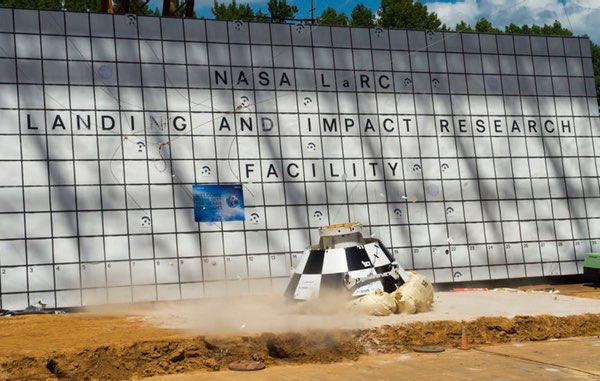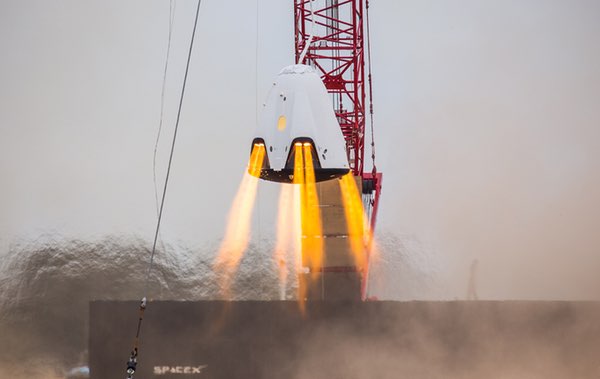Commercial crew: two years after contracts, two years until flightsby Jeff Foust
|
| “We’re optimistic that we’re going to meet the deadline, but we’ll fly when we’re ready, and that’s really what it comes down to,” said Boeing’s Ferguson. |
At the time, and for many months afterwards, the goal was for at least one of the companies to have completed its two test flights—one without a crew and one with two people on board—and be certified to carry crews by the end of 2017. It’s now unlikely either company will meet that goal because of development delays and, in the case of SpaceX, the aftermath of the Falcon 9 pad explosion earlier this month.
Earlier this year, Boeing slipped its schedule for test flights, pushing out the uncrewed test flight of its CST-100 Starliner to the fall of 2017 and a crewed test flight to February 2018. The company said several technical issues encountered during work on the spacecraft, including the spacecraft’s mass and the aeroacoustical loads it placed on its Atlas V rocket during launch, prompted the delays.
During a commercial crew panel session at the AIAA Space 2016 conference last week in Long Beach, California, Chris Ferguson, deputy program manager for commercial crew at Boeing, said the current schedule would allow the CST-100 to achieve NASA certification by June 2018, allowing it to begin flights ferrying crews to and from the ISS. But, he warned, it could slip further.
“It’s a very aggressive schedule,” Ferguson said. “We’re optimistic that we’re going to meet the deadline, but we’ll fly when we’re ready, and that’s really what it comes down to. And if it takes a couple of extra months to ensure we have a safe vehicle, we’ll do just that.”
 A model of a Boeing CST-100 Starliner capsule undergoes a drop test at NASA’s Langley Research Center in Virginia this summer. (credit: SpaceX) |
SpaceX had a more aggressive schedule—at least prior to the Falcon 9 pad accident. At a meeting of the NASA Advisory Council in late July, the agency showed development schedules that included an uncrewed test flight of SpaceX’s Crew Dragon, also known as Dragon v2, in May 2017, followed by a crewed test flight in August 2017. Had SpaceX kept to that schedule, it’s likely the company would have achieved NASA certification by that earlier goal of the end of 2017.
At the conference last week, SpaceX shied away from providing any schedule for its upcoming test flights. “We’re full steam ahead on crew, while we listen to the data and understand what’s going on,” said Benji Reed, director of crew mission management at SpaceX, referring to the ongoing investigation into the pad explosion.
As for when SpaceX will be ready to fly astronauts? “We need to get that capability going, and we need to do it right,” he said. “We’ll fly when we’re ready.”
At a separate panel at AIAA Space 2016, Abhishek Tripathi, director of certification at SpaceX, said the company was pressing ahead with commercial crew work despite the accident. “I still know what I have in front of me for the next day, the next month,” he said. “It doesn’t affect my day-to-day work while they’re working on the anomaly.”
The pad accident, he added, offered SpaceX another opportunity to improve the Falcon 9. “SpaceX has been very committed in our conversations with NASA in making sure that we fly the safest vehicle ever made,” he said. “It’s a commitment we take seriously.”
| “We need to get that capability going, and we need to do it right,” SpaceX’s Reed said. “We’ll fly when we’re ready.” |
Even before the pad accident, though, there was skepticism that either company would be ready to carry NASA astronauts until late 2018. In a report issued September 1—the same day, by coincidence, as the pad explosion—NASA’s Office of Inspector General raised doubts about schedules based on technical problems both companies had experienced.
“Notwithstanding the contractors’ optimism, based on the information we gathered during our audit, we believe it unlikely that either Boeing or SpaceX will achieve certified, crewed flight to the ISS until late 2018,” the report concluded.
In the case of SpaceX, the report cited issued with a shift from propulsive landings on land to, at least initially, splashdowns in the ocean as the current cargo version of Dragon performs. While SpaceX still ultimately plans to land the Crew Dragon on land, the shift to water landings created “significant challenges” to the spacecraft’s design, according to the report, “including complications with vendor components and the effectiveness of the integrated landing system designed to ensure parachutes work and the capsule does not take on excessive water after landing in the ocean.”
That and other issues with Crew Dragon work made it unlikely in the eyes of the NASA inspector general that the spacecraft would be ready for post-certification missions until late 2018. “Accordingly, we anticipate additional schedule slippage and do not expect certified flights by SpaceX earlier than late 2018,” the report stated.
Even before the inspector general’s report, some raised concerns about more delays involving the commercial crew program. NASA’s current contract with Russia for seats on Soyuz flight to the ISS runs through 2018. Extended delays put NASA in a bind: should it purchase additional seats on Soyuz flights in 2019 as an insurance policy—albeit an expensive one, with seat prices now well over $80 million each—for additional delays, or risk losing access to the station should neither company be ready by the end of 2018?
| “Due to the long lead time to procure Soyuz seats, a decision must be made really very shortly—before the end of 2016—to guarantee access to the ISS in 2019,” said Hale. |
A further complication is that, traditionally, NASA has had to purchase Soyuz seats more than two years in advance, to accommodate the production of Soyuz spacecraft. That means NASA may need to make a decision in months about additional seats, long before knowing if either commercial crew company can make the 2018 deadline.
“Due to the long lead time to procure Soyuz seats, a decision must be made really very shortly—before the end of 2016—to guarantee access to the ISS in 2019,” said Wayne Hale, interim chairman of the NASA Advisory Council’s human exploration and operations committee, at a late July meeting, “or we may be forced to reduce or possibly eliminate its crew complement.”
For the time being, though, NASA doesn’t appear to feel rushed to make a decision on Soyuz seats, nor put schedule pressure on Boeing and SpaceX. At AIAA Space 2016, Kathy Leuders, the agency’s commercial crew program manager, emphasized the “fly when we’re ready” mantra of her two companies.
“Obviously, from a commercial crew program standpoint it’s really important that we make sure that we are all ready to fly when we feel like it’s safe to fly our crews,” she said. “We’ve been working schedules, and the goal is to fly as quickly as we safely can, with a goal to fly in 2018.”
